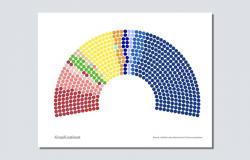This June 30, the part of the MiCA regulation concerning stablecoins comes into force. However, this novelty raises many questions. What are they ?
MiCA: stablecoins must now comply with new rules
Markets in Crypto-Assets : the famous MiCA regulationwhich has been the subject of much discussion for years, comes into force on June 30 for stablecoins. While the text officially came into force exactly one year ago, its application is officially scheduled for December 30, with the exception of sections III and IV relating to stablecoins, which take effect today.
What is MiCA?
This therefore involves several new directives, such as Article 23 prohibiting companies from issuing a stablecoin with a daily volume exceeding one million transactions or a daily volume exceeding $200 million.
Theoretically, this de facto disqualifies famous stablecoins such as USDT or USDC within the European Unionand this already raises several questions.
And for good reason, if we take the example of the French legal framework, in particular with the 2019 Pacte law. Only one company has since obtained its approval as a digital asset service provider (PSAN), namely Société Générale — Forge last year. This example shows the delays that a company must face to comply with the rules, particularly due to a lack of resources within the competent authorities and the costs incurred.
In the case of MiCA, this is all the more difficult, because the companies concerned have therefore had no than one year to understand the implications of the text and comply with it. Added to this is also the fact that a start-up with few legal and financial resources is placed in the same boat as a group like Société Générale, inevitably creating a brake on innovation.
Ledger: the best solution to protect your cryptocurrencies
A 2-step application
Faustine Fleuret, the president of Adan, highlighted these issues in an interview with Euronews, reporting a “difficult and uncomfortable period ».
Furthermore, it is also important to specify a key element: only issuers are currently affected by the part that applies today. For companies that facilitate the circulation of stablecoins, such as centralized exchanges, they theoretically still have 6 months to comply.
The problem is that an exchange that decides not to take these new elements into account, and which continues, for example, to offer its European clients a stablecoin that does not comply with the aforementioned directives, could attract the wrath of the regulator when it itself must obtain its approval in 6 months.
So, this creates inequalities of treatment, as we have seen so far. For example, where Binance will limit the circulation of unauthorized stablecoins on some of its products, others, like Kraken, choose to continue operating normally for as long as possible.
On the same subject — As MiCA regulation approaches, where do euro-backed stablecoins stand?
On the transmitter side, where Circle has already placed its pawnssuch as the opening of a hub in Ireland last year, positioning the company well on its way to joining the ranks, others, such as its competitor Tether, appear further behind.
As a result, the coming months will be crucial in understanding the scope of all these new directives, while a good number of gray areas still need to be cleared up.
Cryptoast Research: Don’t waste this bull run, surround yourself with experts
Newsletter
Receive a summary of crypto news every Monday by email
What you need to know about affiliate links. This page may feature investment-related assets, products, or services. Some links in this article may be affiliate links. This means that if you purchase a product or sign up for a site from this article, our partner pays us a commission. This allows us to continue to provide you with original and useful content. There is no impact on you and you can even get a bonus for using our links.
Investments in cryptocurrencies are risky. Cryptoast is not responsible for the quality of the products or services presented on this page and cannot be held responsible, directly or indirectly, for any damage or loss caused following the use of a good or service highlighted in this article. Investments related to crypto-assets are risky by nature, readers should do their own research before taking any action and only invest within the limits of their financial capabilities. This article does not constitute investment advice.
AMF recommendations. There is no guaranteed high return, a product with a high return potential implies a high risk. This risk-taking must be in line with your project, your investment horizon and your ability to lose part of these savings. Do not invest if you are not prepared to lose all or part of your capital.
To go further, read our Financial Situation, Media Transparency and Legal Notices pages.
Since 2021, I have devoted my free time to seriously educating myself on cryptocurrencies in order to acquire maximum knowledge and credibility. I often have the opportunity to conduct interviews with influential figures in the blockchain industry. I also conduct in-depth analyzes on Web3 themes to offer exclusive content to Cryptoast readers.
Vincent Maire
1231 articles






